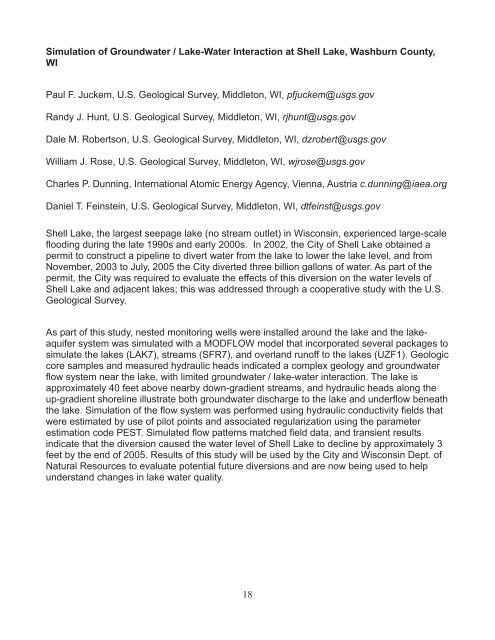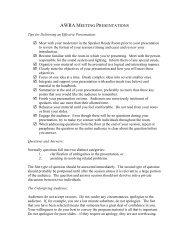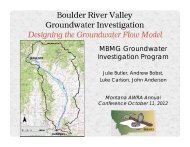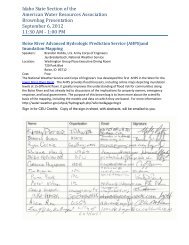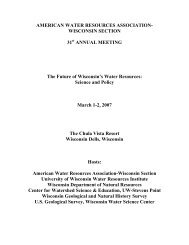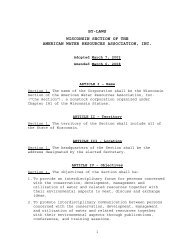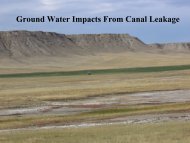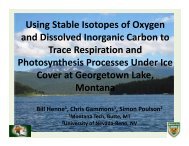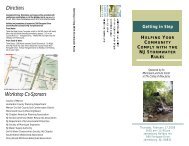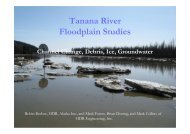Wisconsin's Role in Great Lakes Restoration - American Water ...
Wisconsin's Role in Great Lakes Restoration - American Water ...
Wisconsin's Role in Great Lakes Restoration - American Water ...
You also want an ePaper? Increase the reach of your titles
YUMPU automatically turns print PDFs into web optimized ePapers that Google loves.
Simulation of Groundwater / Lake-<strong>Water</strong> Interaction at Shell Lake, Washburn County,<br />
WI<br />
Paul F. Juckem, U.S. Geological Survey, Middleton, WI, pfjuckem@usgs.gov<br />
Randy J. Hunt, U.S. Geological Survey, Middleton, WI, rjhunt@usgs.gov<br />
Dale M. Robertson, U.S. Geological Survey, Middleton, WI, dzrobert@usgs.gov<br />
William J. Rose, U.S. Geological Survey, Middleton, WI, wjrose@usgs.gov<br />
Charles P. Dunn<strong>in</strong>g, International Atomic Energy Agency, Vienna, Austria c.dunn<strong>in</strong>g@iaea.org<br />
Daniel T. Fe<strong>in</strong>ste<strong>in</strong>, U.S. Geological Survey, Middleton, WI, dtfe<strong>in</strong>st@usgs.gov<br />
Shell Lake, the largest seepage lake (no stream outlet) <strong>in</strong> Wiscons<strong>in</strong>, experienced large-scale<br />
flood<strong>in</strong>g dur<strong>in</strong>g the late 1990s and early 2000s. In 2002, the City of Shell Lake obta<strong>in</strong>ed a<br />
permit to construct a pipel<strong>in</strong>e to divert water from the lake to lower the lake level, and from<br />
November, 2003 to July, 2005 the City diverted three billion gallons of water. As part of the<br />
permit, the City was required to evaluate the effects of this diversion on the water levels of<br />
Shell Lake and adjacent lakes; this was addressed through a cooperative study with the U.S.<br />
Geological Survey.<br />
As part of this study, nested monitor<strong>in</strong>g wells were <strong>in</strong>stalled around the lake and the lakeaquifer<br />
system was simulated with a MODFLOW model that <strong>in</strong>corporated several packages to<br />
simulate the lakes (LAK7), streams (SFR7), and overland runoff to the lakes (UZF1). Geologic<br />
core samples and measured hydraulic heads <strong>in</strong>dicated a complex geology and groundwater<br />
flow system near the lake, with limited groundwater / lake-water <strong>in</strong>teraction. The lake is<br />
approximately 40 feet above nearby down-gradient streams, and hydraulic heads along the<br />
up-gradient shorel<strong>in</strong>e illustrate both groundwater discharge to the lake and underflow beneath<br />
the lake. Simulation of the flow system was performed us<strong>in</strong>g hydraulic conductivity fields that<br />
were estimated by use of pilot po<strong>in</strong>ts and associated regularization us<strong>in</strong>g the parameter<br />
estimation code PEST. Simulated flow patterns matched field data, and transient results<br />
<strong>in</strong>dicate that the diversion caused the water level of Shell Lake to decl<strong>in</strong>e by approximately 3<br />
feet by the end of 2005. Results of this study will be used by the City and Wiscons<strong>in</strong> Dept. of<br />
Natural Resources to evaluate potential future diversions and are now be<strong>in</strong>g used to help<br />
understand changes <strong>in</strong> lake water quality.<br />
18


